You’ll often see these types of ceilings in home residences: conventional ceilings, tray ceilings, and cove ceilings. And they use different types of lighting.
Conventional ceiling presents a flat, simple drywall or plaster level surface; tray ceiling and cove ceiling fall into the category of false ceilings. They are a layer of ceiling constructed on the original ceiling (standard ceiling).
Modern ceiling lighting design favors taking an indirect lighting approach. It aims to create a soft ambient light. Crown molding lighting, cove lighting, valance lighting, and cornice lighting are a few of the most basic forms of indirect ceiling lighting.
How do you choose the right lighting for your ceiling type? Keep reading to find out the answer.
Types of Ceilings
There are a variety of ceiling types including but not limited to conventional ceiling, tray ceiling, cove ceiling, drop ceiling, coffered ceiling, shed ceiling, beamed ceiling, sloped ceiling, dome ceiling, exposed ceiling, vaulted ceiling, and cathedral ceiling.
Below are the characteristics of these ceiling types:
| Ceiling Type | Feature | Lighting Type | Lighting Fixture |
| Conventional Ceiling | A flat drywall/plaster level surface | Direct lighting, indirect lighting | Ceiling lights, suspended lights, crown ceiling moulding lights |
| Tray Ceiling | A layered design that resembles an inverted tray | Direct lighting, indirect lighting | Chandeliers, tray ceiling lighting channels |
| Cove Ceiling | Hidden spaces within the ceiling | Indirect lighting | LED strip lights, cove lighting channels |
| Coved Ceiling | The joint between the wall and the ceiling is set in a curved shape | Indirect lighting | LED strip lights, coved lighting channels |
| Drop Ceiling | Draped ceiling | Direct lighting | Ceiling lights |
| Coffered Ceiling | Ceiling with square or rectangular areas | Direct lighting, indirect lighting | Chandeliers, ceiling lights, LED strip lights |
| Shed Ceiling | Ceiling at a sloping angle to the floor | Direct lighting | Chandeliers, wall sconces |
| Beamed Ceiling | Ceiling with beams, traditional or rural style | Direct lighting | Chandeliers |
| Sloped Ceiling | Ceiling in the attic | Direct lighting | Chandeliers, wall sconces |
| Exposed Ceiling | Ceiling structure exposed | Direct lighting | Track lights |
| Dome Ceiling | Dome-shaped ceiling | Indirect lighting (edge lighting) | LED strip lights |
| Vaulted/Cathedral Ceiling | Intricately designed vaulted/spire-like ceiling in churches or grand buildings | / | / |
Below we highlight conventional ceilings, tray ceilings, and cove ceilings. And the lighting methods they are suitable for. These three ceiling types are the most common in general home construction.
Conventional Ceiling with Crown Molding Lighting
Conventional ceiling is very common in any interior architectural space. Also known as flat ceiling or standard ceiling. This is the most basic and common ceiling type. Conventional flat ceiling doesn’t have any special decorative or design elements. It is only a simple, uniform plane of drywall (plaster).
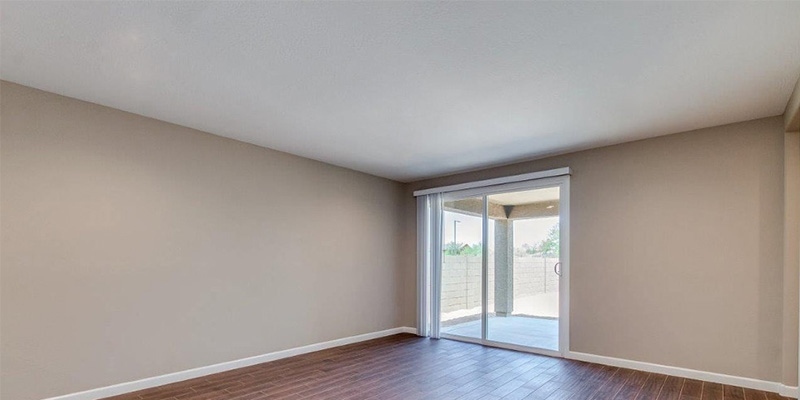
Since the corners formed between a standard ceiling and the walls are too hard, a softening is usually done by installing crown molding trim around the ceiling.
A common choice for lighting a room with a conventional ceiling is to install a ceiling light or pendant light in the center. This type of primary lighting directs the light downward, and the light fixture can be uncomfortable for the eyes in the line of sight.
To fix this discomfort, more and more home decorators are choosing to add lighting to their ceiling crown molding. Crown moulding lighting allows light fixtures to be hidden, with the light traveling up toward the ceiling and being reflected throughout the room. This indirect lighting creates a comfortable lighting environment.
Traditional vs Modern Ceiling Crown Molding
Traditional crown molding in solid wood, marble, and plaster is mostly delicate and elegant, often incorporating classical elements and featuring intricate carvings and decorations.
Modern crown molding is mostly clean and simple, favoring clear, geometric lines and shapes, and the materials used (metal, plastic) are lighter.
There is a new type of modern crown moulding. It combines simple aluminum crown molding with LED strip lighting, simplifying the installation of crown molding lighting. Some LED crown moldings can be fixed directly to the wall near the ceiling or blended into the wall, such as our QSG-2655 and QSG-2696.
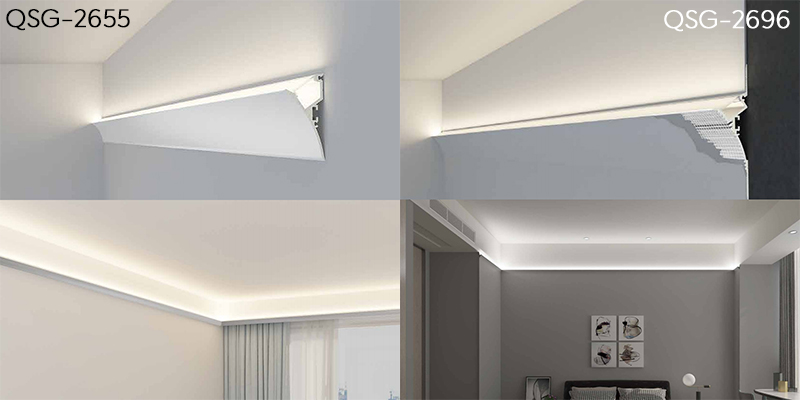
Some LED crown mouldings with curves are perfect for coved ceilings, such as our QSG-7058 and BY-HG6. Coved ceiling softens the edges of a room by placing arched crown molding where the walls meet the ceiling, on the base of the conventional ceiling.
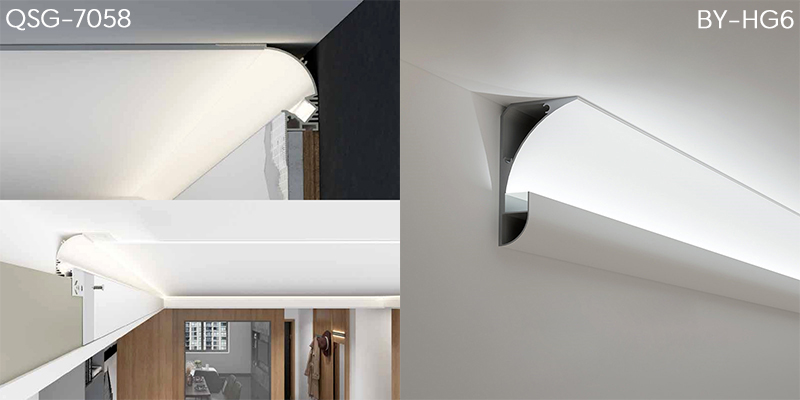
Tray Ceiling With Indirect Lighting
A tray ceiling is a layered ceiling design where the center section is higher than the ceiling border and has a high recessed area in the middle. It is so named because such a ceiling design is like an inverted tray. Tray ceilings gather the visual focus of a room and are often used in main areas such as living rooms and dining rooms.
Tray ceiling lighting is achieved by installing light fixtures around the edges. To emphasize the tray shape and enrich the level of space. Of course, chandeliers are still a common choice for tray ceiling lighting.
The tray ceiling we are talking about here is the one where the edges are without a hidden interior. If this tray ceiling type is to create continuous strip lighting, it is best to use some specialized tray ceiling profiles to accommodate the light strips.
These tray ceiling lights profiles (QSG-4118B, QSG-4118B-LR, QSG-4118C) come with flanges for plaster-in, firmly fixed at the border of the tray ceiling. They outline the shape of square or round tray ceilings very well. Again, the light from these tray ceiling light profiles is directed upwards, indirectly providing a soft illumination of the entire room area.
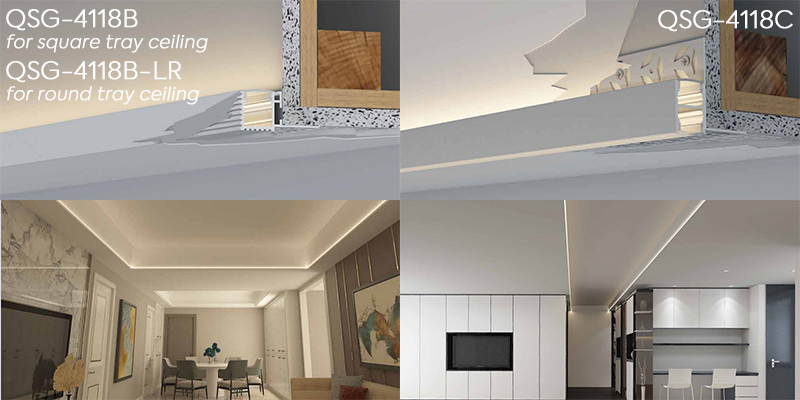
Cove Ceiling and Cove Lighting
Some people would categorize a ceiling with hidden areas as a tray ceiling, but I prefer to call it a recessed ceiling or cove ceiling. This type of cove ceiling design with a hidden interior is best suited to accommodate strip lighting.
Cove lighting is a basic form of indirect lighting that utilizes coves in the ceiling to hide the light source. Cove lighting directs light towards the ceiling plane, illuminating the space with diffused light. This is done to create a soft, even light distribution.
You can understand cove lighting as ambient lighting where you don’t see the light source directly. The soft background lighting it creates adds to the comfort and ambiance of the room.
Why is LED strip light the best choice for cove ceilings?
- LED strip lights are flexible enough to adapt to different cove ceiling shapes and sizes.
- LED strips have a long and narrow luminous area that provides even light distribution and is well hidden.
- With LED light strips, you can choose the color and color temperature of the cove lighting as needed. And it’s adjustable.
- Cove light profiles can be matched to enhance the effect and are easy to clean.
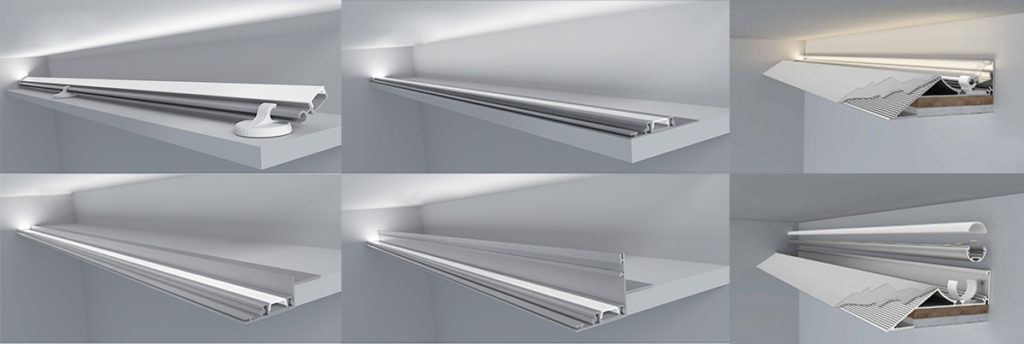
Considerations for Cove Ceiling Lighting
The structure of a cove ceiling makes it susceptible to dust accumulation. When designing cove lighting, it is recommended that the LED strips are well protected against dust, for example by using cove light profiles to wrap the LED strips or by purchasing silicone coated LED strips directly. This is easy to clean.
In order to achieve a completely uniform ceiling cove lighting effect, the intensity of the LED light can be reduced by using a diffuse cover.
The Difference Between Various Types of Indirect Ceiling Lighting
We elaborated above on what crown lighting and cove lighting are. Cornice lighting and valance lighting are essentially not that different from crown lighting.
They are both installed around the ceiling and high up on the walls, hiding the light source inside the structure to achieve a soft, even ceiling lighting effect by reflecting or diffusing light.
How to Choose LED Ceiling Lighting?
Ceiling lighting is generally required to be able to run longer distances with limited power supply, whether it is a living room ceiling, kitchen ceiling, or bedroom ceiling. With this requirement, the voltage of the led celing lights strip would have to be at 24V, 36V or 48V, as a higher voltage also means the longer length of the light strip it can carry.
You can choose a single white ambient color temperature light like 3000K warm white or 6000K daylight for your ceiling lighting or you can choose color changing lights such as RGB or RGBW to create different ambient needs.
If you are looking for led strip lighting for your ceiling, please check out the products below:
| Voltage | Model | Color | LED Type | Max Length (with one end power) |
| 24V | FSLCOB-24V-384X20 | White | COB | 20m (65.6ft) |
| 24V | FSLCC-30M-2835X90 | White | SMD2835 90/m | 30m (98.4ft) |
| 24V | FSLCC-20M-2835X120-24V | White | SMD2835 120/m | 20m (65.6ft) |
| 24V | FSLSR-IP20-5050X300-L20 | Solid Color | SMD5050 | 20m (65.6ft) |
| 24V | FSLRGB-IP20-5050X300-L20 | RGB | SMD5050 | 20m (65.6ft) |
| 24V | FSLCCRGBW-15M-5050X60 | RGBW | SMD5050 | 20m (65.6ft) |
| 48V | FSLCC-48V-2835X136 | White | SMD2835 136/m | 30m (98.4ft) |
| 48V | FSLCC-30M-2835X180 | White | SMD2835 180/m | 30m (98.4ft) |
| 48V | FSLCOB-48V-480W8 | Solid Color | COB | 20m (65.6ft), 30m (98.4ft) |
| 48V | 48V-CCT-2835X224W10 | CCT | SMD2835 | 30m (98.4ft) |
| 48V | FSLCCT-DC48V-2835X224 | CCT | SMD2835 | 30m (98.4ft) |
| 48V | 48V-CCT-40MX240 | CCT | SMD2835 | 40m (131.2ft) |
| 48V | 48V-RGB-20MX10 | RGB | SMD5050 | 20m (65.6ft) |
| 48V | 48V-RGB-50MX54 | RGB | SMD5050 | 50m (164ft) |
| 48V | 48V-RGBW-30MX10 | RGBW | SMD5050 | 30m (98.4ft) |
| 48V | 48V-RGBW-40MX108 | RGB+W | SMD5050 | 40m (131.2ft) |
| 48V | 48V-RGBWW-20MX90 | RGBCCT | SMD5050 | 20m (65.6ft) |